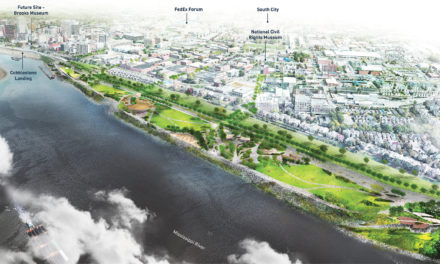By far, the most exciting part of the “Main to Main Multi-Modal Connector Project” for us is that it is supposed to fix the eyesores and poor maintenance that have plagued Main Street for more than 15 years, sending the message that Memphis is a city that doesn’t really care for itself.
We’ve gone down the list of our grievances on this blog several times previously: the 59 plywood patches, some of them more than eight feet long between Poplar and Peabody Place; erratic signage and visually jarring trolley pole signage; shattered pavers that populate every block; lack of commitment to landscaping and streetscaping; missed opportunities for public art, and a pervasive lack of interest in quality design.
Its current state is made all the more remarkable in that the much-lauded Sustainable Shelby project about four years ago – using public polling and more than 125 people on committees – sifted through hundreds of recommendations and dozens of great ideas and came up with the #1 priority: to create a great public realm.
Surely, there is no place that should reflect a city’s best public realm more than its Main Street. City officials have said that some Main to Main improvements will begin in two months but it sounds like Main Street will be come later as “quality engineering” brings costs within budget.
Make the Main Thing The Main Thing
We are hopeful that Main Street gets priority although that may not be possible within the terms of the grant funding which sets out the project to be constructed. While the addition of a bike/ped crossing to the Harahan Bridge should be an interesting addition to the riverfront – if the design can be improved to make sure the experience is as good as it can possibly be – its ultimate success likely depends on the addition on the Arkansas side of something worth going regularly across the bridge to see. Although West Memphis often gets a bad rap, we are hard-pressed to imagine that many people will continue on to its business district unless there is more there to see.
There are some interesting ideas being considered for the Arkansas side of the river, notably a trail and a nature center on the riverbank. It would have been perfect if there had been the potential to create a circular loop that included the Memphis riverwalk, the Harahan Bridge, a trail/nature center along the Arkansas riverbank, and then back to Memphis across the Hernando de Soto Bridge. It would create something with more interest, but unfortunately, it’s not possible for this to work on the “new” bridge.
While Main to Main is all well and good, there is no priority that says more about Memphis, its self-image, and its national image than Main Street.
Proving We Can Do It Well
We’ve had questions from the beginning about whether this project could be completed for the roughly $30 million budget – half federal grant and half local, state, and private money – and we have been particularly concerned about the extent of the improvements to Main Street where the needs are pervasive.
In a perfect world, it’s easy to imagine that Main Street alone could consume most of the funding, but the amount earmarked for Main Street will repair or replace broken sidewalks, curbs and gutters, ensure ADA compliance, eliminate cast-iron planter boxes, and replace trench drains with grate-covered storm drains.
We have no doubts that when officials talk about value engineering, they are also referring to the Main Street piece of the project. That is unfortunate, because regardless of this grant and this project, City of Memphis has responsibility to provide a quality Main Street, and its repair, rehabilitation, and improvement should be done right.
We wish that the Downtown Memphis Commission would develop the budget for a plan that produces the kind of design-conscious, high quality Main Street that Memphis deserves. If that amount – as is likely – is more than the amount in the Main to Main budget, City of Memphis should be asked for the money to do it right.
The High Price of Cheapness
There are some major high-profile downtown projects under way now and there’s even talk about a new convention center, but Memphis needs to put as much attention to getting its basic infrastructure right. If that requires CIP funding from the city budget, we should create a coalition to lobby for it just like the groups successfully campaigning for direct financial incentives for private projects.
We have seen the consequences of doing it cheap. After the pedestrian mall was opened in 1976, Main Street almost immediately started showing signs of wear and tear because of “quality engineering” that led to cheaper and cheaper materials.
Hopefully, we don’t have to learn that lesson again. It would be good to establish what the cost would be for doing Main Street right rather than trying to shoehorn it into a budget driven by “free” money from the federal government.
This is a symptom of a serious problem in Memphis. We seem to have no real list of priorities. We have a list of things we’d like to do, but the one that moves immediately to the top of the list is the one for which we can get federal or state grants for.
First Things First
Unfortunately, there doesn’t seem to be a policy that requires a projection of life cycle costs, much less a maintenance budget to make sure city investments continue to look good and run right. Too often, we wait for it to become a crisis and even then, we wait for the largess of state or federal government before we address it.
As Chuck Marohn advised Memphis a year ago: “Memphis needs to do a full evaluation to determine its long-term obligations. The city needs to prepare a real capital improvements plan instead of it being simply a wish list of future projects. The plan should list all infrastructures that the community is committed to maintain, including park facilities and public buildings; estimate the useful life and remaining capacity of each; estimate the cost of repairs when that useful life is completed; estimate the cost of expansion for infrastructure components that have limited capacity; correlate these values with value of the area served by the improvements; estimate the revenue stream available to support these commitments; develop a capital improvement plan within the given revenue projections; perform a productivity analysis showing the tax return per acre throughout the City of Memphis; and inventory properties currently held by the City and assess them for their development potential.”
His sound recommendations make even more sense today than they did a year ago. Simply put, it makes no sense to keep adding new projects if we can’t take care of the ones we already have.






